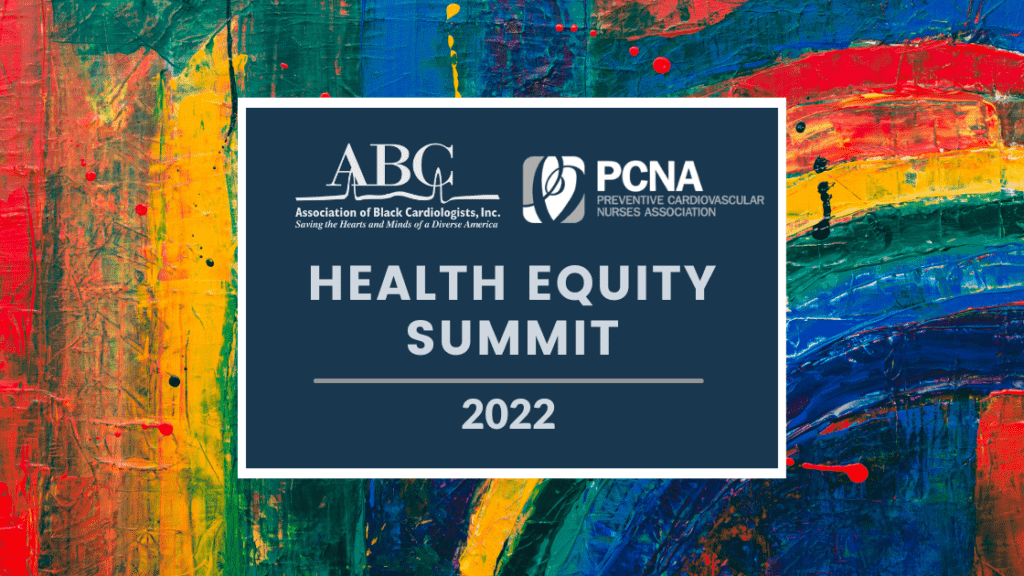Recapping the 2022 Health Equity Summit
Health Equity Every Day

Focusing on health equity every day ensures that each of our patients has access to care, information, and resources to keep them as healthy as possible. Not only does this help in cardiovascular disease (CVD) prevention, but also improves outcomes for our patients who already have CVD. While many organizations have strategies in place to work to address health disparities, it is incumbent on each health care professional (HCP) to keep this important topic not only in mind but also in practice, each day.
PCNA partnered with the Association of Black Cardiologists to share current statistics as well as clinically-applicable strategies during the 2nd annual Health Equity Summit in September 2022. This two-day virtual event consisted of presentations by health equity subject matter experts, and panel discussions of questions submitted by the audience, which provided even more information about this timely and critical topic.
Cultural Safety, Cultural Competency, Cultural Humility
Diana Baptiste, DNP, RN, CNE, FPCNA, FAAN shared information and data from nursing research about the differences between cultural safety and cultural competency and the importance of recognizing the impacts of the social determinants of health on our patients and communities. Dr. Baptiste described the burden of CVD risk factors on non-Hispanic Blacks in the U.S., as well as the continuing disease prevalence in individuals who are Asian and Latino. She also discussed the concept of cultural humility and how it can be applied in practice to ensure reduced health disparities in the patients whom we serve. Watch the recording of this presentation.
Treatment Bias Impacts on CV Health of LGBTQ+ Patients
Billy Caceres, PhD, RN, FAHA, FAAN, focused on treatment bias and its impact on the CV health of LGBTQ+ patients, who are also known as sexual and gender minority populations. With an estimated 14 million US adults identifying as LGBTQ+, these individuals are likely part of your clinical practice setting. Negative health outcomes in these individuals are often linked to minority stress, which may compound general life stressors (work, financial strain, etc.) faced by our patients in general. Nurses are well-positioned to make a significant impact in addressing prevention and treatment gaps for these patients. Watch the recording of this presentation.
Maternal Mortality and CV Health
Kecia Gaither, MD, MPH, MS, MBA, FACOG, shared about the continuing increase in maternal mortality and the risk factors that impact maternal and general health. Dr. Gaither reviewed the physiologic changes in pregnancy and the effects that can last even after childbirth, as well as key considerations in differentiating symptoms of pregnancy versus those that are cardiac-related. Dr. Gaither promoted the use of universal screening during pregnancy—a prime time to identify underlying symptoms as well as provide education for those who are pregnant and their family members/support systems. Watch the recording of this presentation.
Links Between Environmental Quality & CV Health
There is a strong link between the environment and cardiovascular health. Katie Huffling, DNP, RN, CNM, FAAN, encouraged participants to consider the implications for their patients. There are baseline factors to consider—such as living close to a highway, nearby polluting industries, workplace exposure to toxins, lack of heating/cooling, or access to food or green space. Nurses are also well positioned to use anticipatory guidance to help patients prepare for severe weather events to minimize potential lack of access to medications, exacerbation of symptoms due to excessive heat, and more. Watch the recording of this presentation.
CV Health of Immigrant, Displaced & Unhoused Populations
Providing a global perspective, Yvonne Commodore-Mensah, PhD, MHS, RN, and Abeer Alharthi, MS, RN, PhD student, co-presented on CV health among populations who are immigrants, displaced, or unhoused. Like other populations discussed during the summit, these populations are not heterogeneous, but there are shared factors—such as the stress of displacement, unequal access to health care, and changes in diet due to food sources available in the new home country which can significantly contribute to dyslipidemia, hypertension, and diabetes. Migration is an issue that can impact CV health both within and between countries and is one of the social determinants of health along with individual and lifestyle factors, working conditions, and many others. Watch the recording of this presentation.
Impacts of Poverty and Race on Peripheral Artery Disease (PAD) and Lower Limb Amputation
PAD can lead not only to lifestyle complications but also lower limb amputation and premature mortality—and the disease and its impacts disproportionately affect individuals of minority populations. Alexander Fanaroff, MD, MHS, described the pathophysiology of PAD and how the social determinants of health impact care, treatment, and adherence. In addition to the diagnosis and treatment of symptomatic patients, it is important to consider risk factors for asymptomatic patients to avoid disease progression to critical limb ischemia. Watch the recording of this presentation.
Find Out More
Watch the recordings of the 2022 Health Equity Summit in our Online Learning Library. Each of the sessions can be found below:
- Cultural Safety versus Cultural Competency in the Pursuit of Health Equity
- Environmental Justice and Cardiovascular Health
- Cardiovascular Health Among Immigrant, Displaced, and Unhoused Populations
- Reducing Maternal Mortality through Comprehensive Antenatal and Postnatal Cardiovascular Care
- Treatment Bias and Cardiovascular Health of LGBTQ+ Patients
- Peripheral Artery Disease Lower Limb Amputation: An Epidemic of Poverty and Race
